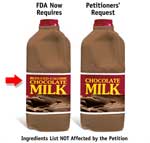If chocolate milk is low calorie, should the label have to say so? That is the question before the U.S. Food and Drug Administration (FDA) which has been flooded with comments about a proposed change to milk labeling rules.The agency has received more than 30,000 comments on the issue, many of which indicate consumers are confused about what exactly is being proposed, according to Mary Poos, Ph.D., deputy director of FDA’s Office of Nutrition, Labeling and Dietary Supplements.
 When natural sugar in flavored milk is replaced with a non-nutritive sweetener such as aspartame, sucralose, or acesulfame potassium, it reduces the calorie count. Existing rules require that that information appears prominently on the package with phrases such as “reduced calorie” and that the specific name of the artificial sweetener be listed in the ingredients.
When natural sugar in flavored milk is replaced with a non-nutritive sweetener such as aspartame, sucralose, or acesulfame potassium, it reduces the calorie count. Existing rules require that that information appears prominently on the package with phrases such as “reduced calorie” and that the specific name of the artificial sweetener be listed in the ingredients.
But the International Dairy Foods Association (IDFA) and the National Milk Producers Federation (NMPF) would like the rule changed. Both groups still want the specific name of the sweetener to appear in the list of ingredients, but they don’t want the label to have to say “lower calorie” or “reduced calorie” because those phrases are turnoffs to the target market for chocolate milk: children.
The groups say changing the rule would promote more healthful eating practices and reduce childhood obesity. However, in addition to flavored milk, the proposed rule would affect 17 other dairy products including nonfat dry milk, heavy cream, eggnog, half-and-half and sour cream, products that can’t claim children as their target market.
“If we granted the petition, a carton of chocolate milk made with non-nutritive sweeteners would simply say ‘chocolate milk,’ the same as a carton made with nutritive sweeteners, such as sugar,” said Felicia Billingslea, director of FDA’s Food Labeling and Standards in a statement. “You would need to read the ingredient list, which is typically on the back or the side of the product, in order to tell the difference between the two.”




